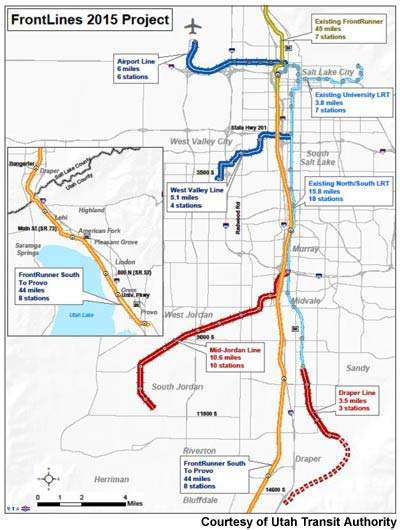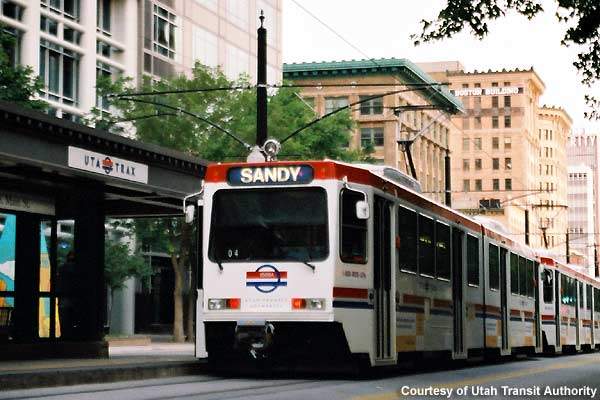The US state of Utah is growing rapidly and so is its population. Inhabitants totalled 2.9 million at the beginning of 2009, and the figure is expected to increase to 3.9 million by 2030. A majority of this rise will see people will settle along the 80-mile Wasatch Front, one of the most populated areas in the state.
The increasing population means additional road traffic and vehicle trips along the Wasatch Front. Travel demand in Utah is growing at 4% every year, and the number of daily vehicle trips is expected to have doubled by 2030.
Development of five Utah-based rail lines
In 2004, the Wasatch Front Regional Council (WFRC) and elected officials recommended advancement of the 2030 Long-Range Transportation Plan, an initiative by the Utah Transit Authority (UTA) aimed at developing traffic infrastructure for future needs.
UTA accordingly decided to finish the construction of five rail lines, which were initially part of the 2030 Long-Range Transportation Plan, by 2015.
The project was named FrontLines 2015 and involved construction of four light rail lines and one commuter rail line with a $2.85bn investment.
Light rail or TRAX is preferred for shorter distances and can accommodate a greater number of stops. It runs on electricity and reaches maximum speeds of close to 65mph. Commuter rail runs on diesel, has two-level passenger coaches and attains speeds close to 79mph.
All stations have passenger platforms, parks, ride lots and bus bays.
Funding
The accelerated delivery of the project required additional funding. In August 2007, UTA signed a memorandum of understanding (MoU) with the US Federal Transit Administration (FTA), under which the FTA agreed to give $570m in funding for the extension of the Mid-Jordan and Draper lines.
The general public was approached to fund the other rail lines. The proposal was put forward for public opinion in Utah and Salt Lake counties, where people accepted a quarter-cent increase in sales tax to expedite construction.
Front Runner
Front Runner or Front Runner South is the only commuter rail under the FrontLines project. It runs 44 miles from Provo in Utah County, to the Salt Lake Central Station in Salt Lake City.
An extension of UTA’s existing Front Runner North, the line was constructed on the east side of the Union Pacific Railroad until Salt Lake County with eight (or ten) stations. The eight stations already determined are Murray, South Jordan, Draper/Bluffdale, Lehi, American Fork, Vineyard, Orem and Provo.
Work began on 12 August 2008 and the line was completed in June 2013.
Motive Power supplied ten locomotives and Bombardier supplied ten cab cars and eight passenger cars, as well as revamped ten comet passenger cars to be used on the line.
Airport light rail line
The Airport Trax is a six-mile light rail line was constructed with a $250m-$300m investment. The construction of the line began on 22 October 2008. The line runs from downtown Salt Lake City to North Temple to the Salt Lake City International Airport with six or more stations.
The six stations are Transfer Station to/from FrontRunner (Commuter Rail) at 500 West, 800 West, Fair Park, Cornell, Winifred and Salt Lake International Airport. The construction was completed by 2013.
The estimated travel time along the line is around 20 minutes. The line is a convenient mode of transport for business travellers to commute from the airport to business centres, hotels and nearby tourist places.
Details of the Draper Line
Draper Line is a 26.5 square-mile light rail beginning from the current terminus of the Sandy/Salt Lake TRAX Line at 10000 South and extending up to 14600 South. In 2008, UTA, in association with the FTA, completed the conducting of an environmental study of the several possible alignments for the track.
The project received FTA and public approval and construction of the line began in the second quarter of 2009. The project was completed by June 2013.
Mid-Jordan light rail
The ground-breaking ceremony for the 10.6-mile Mid-Jordan project took place in May 2008. The light rail line was built with a $452m investment and passes through Murray, Midvale, West Jordan and South Jordan. The line was opened to traffic in August 2011.
The new line has nine stations located at 6400 South 500 West, 7800 South 1100 West, Redwood Road, 2700 West in West Jordan, Bangerter Highway, 4800 West in West Jordan, 5600 West in West Jordan, Daybreak North and Daybreak South.
An estimated 30,000 passengers use the rail line every day.
Details of the West Valley line
The light rail West Valley line is 5.1-miles long and was laid with an investment between $250 and 290m. The construction of the line began on 18 June 2008 and it features ballasted double tracks. It begins from the existing 2100 South Trax Station in South Salt Lake and moves towards south-west up to West Valley City Hall’s future intermodal centre.
The line features four new stations at Chesterfield, Decker Lake, E-Center and West Valley City Intermodal Center. The total journey time is approximately 14 minutes and the number of passengers is expected to reach 12,000 daily by 2025. The line was opened to public in August 2011.






